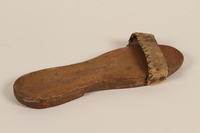Overview
- Description
- Contains twelve photographs and copy prints documenting Jewish life in Vienna, Austria; Kobe, Japan; and Shanghai, China in the World War II era.
- Credit Line
- United States Holocaust Memorial Museum Collection, Gift of Judith Kranzler
- Collection Creator
- Judith Kranzler
Physical Details
- Genre/Form
- Photographs.
- Extent
-
1 folder
Rights & Restrictions
- Conditions on Access
- There are no known restrictions on access to this material.
- Conditions on Use
- The Museum is in the process of determining the possible use restrictions that may apply to material(s) in this collection.
Keywords & Subjects
- Geographic Name
- Vienna (Austria). Kobe (Japan) Shanghai (China).
Administrative Notes
- Holder of Originals
-
United States Holocaust Memorial Museum
- Legal Status
- Permanent Collection
- Provenance
- Donated to the United States Holocaust Memorial Museum in 2010 by Judith Kranzler.
- Record last modified:
- 2024-01-31 14:46:04
- This page:
- https://collections.ushmm.org/search/catalog/irn43115
Download & Licensing
- Copyright Not Evaluated
- Terms of Use
- This record is not digitized and cannot be downloaded online.
In-Person Research
- Request 7 Days in Advance of Visit
- Plan a Research Visit
-
Request in Shapell Center Reading Room
Bowie, MD
Contact Us
Also in Judith Kranzler collection
The collection consists of a pair of sandals relating to the experiences of Lazar Horodetzky, a member of Mir Yeshiva, in the Hongkew ghetto in Shanghai, China, and copy prints and photographs documenting Jewish life in Vienna, Austria, Kobe, Japan, and Shanghai, China, during the Holocaust.
Date: 1939-1945

Wooden sandals with a canvas strap worn by a Mir Yeshiva refugee in Shanghai
Object
Wooden sandals worn by Lazar Horodetzky in Hongkew ghetto in Shanghai, China, from 1941-1945. Lazar was a member of Mir Yeshiva, a Jewish religious school which left Mir, Poland (Belarus) after the Soviet occupation in September 1939. They first moved to Vilna (Vilnius), Lithuania. When it was occupied by the Soviets in August 1940, they fled again, after obtaining Japanese transit visas from consul Chiune Sugihara. In spring 1941, they reached Japan, where they were declared stateless refugees and deported to Japanese occupied Shanghai. They settled in Hongkew and resumed their studies. The city was liberated by US troops on September 3, 1945. Mir Yeshiva was the only eastern European yeshiva to survive the Holocaust intact. The yeshiva members immigrated to Palestine and to the United States, assisted by the Mirrer Yeshivah in New York.



